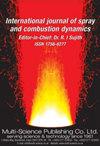熵波发生器实验中间接燃烧噪声的大涡模拟预测
IF 2.1
4区 工程技术
Q3 ENGINEERING, MECHANICAL
International Journal of Spray and Combustion Dynamics
Pub Date : 2018-06-01
DOI:10.1177/1756827717740775
引用次数: 9
摘要
将熵波发生器实验亚音速工作点的紧致和非紧致解析解与大涡模拟获得的详细数值结果进行了比较。提出了两种能量沉积方法来解释实验点火顺序和几何结构:先前使用的单块沉积和紧密再现实验协议的延迟沉积。假设未知的入口声反射系数是完全反射的,以便与实际实验设置在物理上更加一致。必须考虑加热模块激活之间的时间延迟,以检索振动计测量的温度信号和麦克风处的压力信号。此外,使用延迟点火模型从出口管道中的大涡流模拟中提取的压力信号比分析模型更好地清晰地再现了实验信号。在计算域的入口处直接注入实际温度波动的额外模拟清楚地表明,由热段塞加速产生的压力波动几乎完全产生间接噪声。最后,当通过熵波发生器喷嘴中的湍流对流时,熵斑被显示为失真。其振幅减小,形状分散,但几乎不发生任何耗散。通过喷嘴,畸变似乎可以忽略不计,只有在下游管道中长距离对流时,畸变才变得重要。由于熵波发生器熵强迫的主频率很低,因此平均流的色散效应很弱。本文章由计算机程序翻译,如有差异,请以英文原文为准。
Large-Eddy-simulation prediction of indirect combustion noise in the entropy wave generator experiment
Compact and non-compact analytical solutions of the subsonic operating point of the entropy wave generator experiment are compared with detailed numerical results obtained by large Eddy simulations. Two energy deposition methods are presented to account for the experimental ignition sequence and geometry: a single-block deposition as previously used and a delayed deposition that reproduces the experimental protocle closely. The unknown inlet acoustic reflection coefficient is assumed to be fully reflective to be more physically consistent with the actual experimental setup. The time delay between the activation of the heating modules must be considered to retrieve the temperature signal measured at the vibrometer and pressure signals at the microphones. Moreover, pressure signals extracted from the large Eddy simulations in the outlet duct using the delayed ignition model clearly reproduce the experimental signals better than the analytical models. An additional simulation with actual temperature fluctuations directly injected at the inlet of the computational domain clearly shows that the pressure fluctuations produced by the acceleration of the hot slug yields indirect noise almost entirely. Finally, the entropy spot is shown to be distorted when convecting through the turbulent flow in the entropy wave generator nozzle. Its amplitude decreases and its shape is dispersed, but hardly any dissipation occurs. The distortion appears to be negligible through the nozzle and become important only when convected over a long distance in the downstream duct. As the dominant frequencies of the entropy wave generator entropy forcing are very low, the effects of dispersion by the mean flow are however weak.
求助全文
通过发布文献求助,成功后即可免费获取论文全文。
去求助
来源期刊

International Journal of Spray and Combustion Dynamics
THERMODYNAMICS-ENGINEERING, MECHANICAL
CiteScore
2.20
自引率
12.50%
发文量
21
审稿时长
>12 weeks
期刊介绍:
International Journal of Spray and Combustion Dynamics is a peer-reviewed open access journal on fundamental and applied research in combustion and spray dynamics. Fundamental topics include advances in understanding unsteady combustion, combustion instability and noise, flame-acoustic interaction and its active and passive control, duct acoustics...
 求助内容:
求助内容: 应助结果提醒方式:
应助结果提醒方式:


